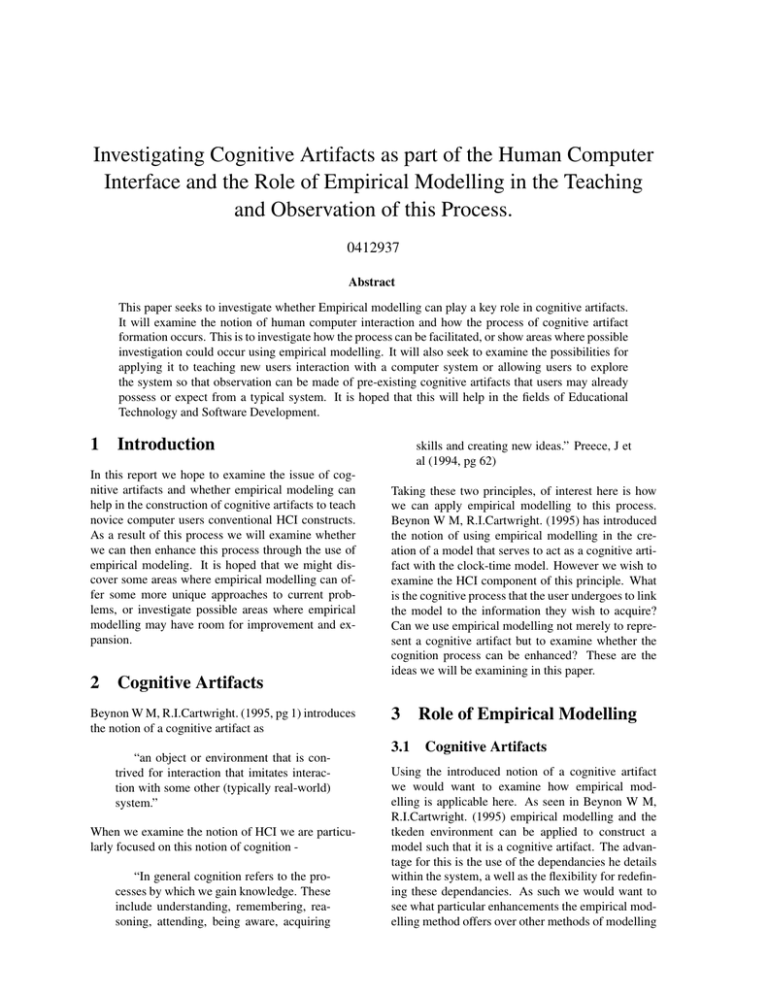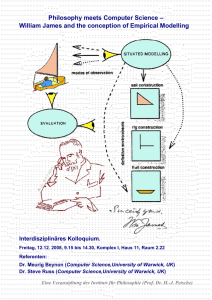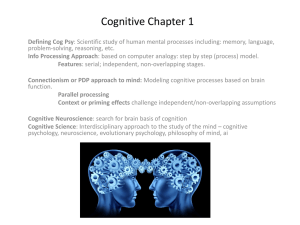Investigating Cognitive Artifacts as part of the Human Computer
advertisement

Investigating Cognitive Artifacts as part of the Human Computer Interface and the Role of Empirical Modelling in the Teaching and Observation of this Process. 0412937 Abstract This paper seeks to investigate whether Empirical modelling can play a key role in cognitive artifacts. It will examine the notion of human computer interaction and how the process of cognitive artifact formation occurs. This is to investigate how the process can be facilitated, or show areas where possible investigation could occur using empirical modelling. It will also seek to examine the possibilities for applying it to teaching new users interaction with a computer system or allowing users to explore the system so that observation can be made of pre-existing cognitive artifacts that users may already possess or expect from a typical system. It is hoped that this will help in the fields of Educational Technology and Software Development. 1 Introduction In this report we hope to examine the issue of cognitive artifacts and whether empirical modeling can help in the construction of cognitive artifacts to teach novice computer users conventional HCI constructs. As a result of this process we will examine whether we can then enhance this process through the use of empirical modeling. It is hoped that we might discover some areas where empirical modelling can offer some more unique approaches to current problems, or investigate possible areas where empirical modelling may have room for improvement and expansion. 2 Cognitive Artifacts Beynon W M, R.I.Cartwright. (1995, pg 1) introduces the notion of a cognitive artifact as “an object or environment that is contrived for interaction that imitates interaction with some other (typically real-world) system.” When we examine the notion of HCI we are particularly focused on this notion of cognition “In general cognition refers to the processes by which we gain knowledge. These include understanding, remembering, reasoning, attending, being aware, acquiring skills and creating new ideas.” Preece, J et al (1994, pg 62) Taking these two principles, of interest here is how we can apply empirical modelling to this process. Beynon W M, R.I.Cartwright. (1995) has introduced the notion of using empirical modelling in the creation of a model that serves to act as a cognitive artifact with the clock-time model. However we wish to examine the HCI component of this principle. What is the cognitive process that the user undergoes to link the model to the information they wish to acquire? Can we use empirical modelling not merely to represent a cognitive artifact but to examine whether the cognition process can be enhanced? These are the ideas we will be examining in this paper. 3 3.1 Role of Empirical Modelling Cognitive Artifacts Using the introduced notion of a cognitive artifact we would want to examine how empirical modelling is applicable here. As seen in Beynon W M, R.I.Cartwright. (1995) empirical modelling and the tkeden environment can be applied to construct a model such that it is a cognitive artifact. The advantage for this is the use of the dependancies he details within the system, a well as the flexibility for redefining these dependancies. As such we would want to see what particular enhancements the empirical modelling method offers over other methods of modelling when applied to the interfface and it’s definitions. If we are to examine HCI we must consider that it is for the large part imperfect. Cognitive artifacts rely on a mapping to a real world system(Beynon W M, R.I.Cartwright. (1995)). We may find cases where the means of interaction is unfeasible to readily translate to a computer representation, or where room exists for improvement. We introduce here the LSD notation system from Beynon W M, Russ S (2006). In particular we take the train model within from pg 4. The LSD notation system details numerous aspects of a system, such as the states and the observables, as well as the protocols. However the difficulty lies within translating these to a computer system. In particular, not all inputs are well suited to translation. Pushing a button has a fairly obvious counterpart within a computer system, but what about blowing a whistle? Having a button to simulate it is one possible means, but it discounts numerous factors such as location, noise levels etc. If there are factors that are lost in the interpretation, it may not always be the case that a user can form a complete cognitive artifact of the system it is intended to simulate, and thus we might conclude that there is possible room for improvement. LSD seems well suited for identifying protocols that need to be modeled, but maybe not as well suited for how they are to be displayed. This means it is a possible area for investigation, and perhaps the use of constructivism for observation and teaching would help us in this regard. 3.2 Constructivism and Cognition “EM is predicated on the thesis that cognition and learning are fundamentally concerned with a process of construing phenomena in terms of agency and dependancy” Beynon. W M (1997, pg 4) The area in which we might see the best use of empirical modelling is constructivism. When examined alongside cognition it would seem that the two have similarities. Cognition is the process of gathering information Preece, J et al (1994, pg 62) With constructivism “of particular significance in the constructionist tradition are environments that support ’active learning’ in which learners are actively involved in building their own public artifacts” Beynon M, Roe C (2004, pg 1) This is important because it highlights the act of artifact construction through experimentation as indicated above. If we wish to analyse the effectiveness of artifact construction then we would need to find a process where we can observe this, and constructivism seems to support this role. In particular because cognitive artifacts are formed by relating to a real world system, the experimentation of constructivism would be conducive to a user learning how the computer system works and then mapping it to the real life system they feel it matches best. “One of the basic issues in developing an artifact is the choice of mapping between the representing world and the represented world (or between the surface representation and the task domain being supported by the artifact). In the mapping between the represented world and the representing world of the artifact. the choice of representation determines how faithfully the match is met.” Norman, Donald A (1991) 4 Modelling The model is intended to use a number of different input types in order to demonstrate how different interpretations could be achieved simply by changing the way the user interacts with the system. Initial ideas for a model were a maze the user had to traverse. However this is rather limiting in how input is handled, and so a more simplistic model of drawing was adopted. 4.1 Running the model There are two separate files which detail a model that is similar in function but different in input methodology. To run the keypad model run the script in clickinput.s. To run the freehand model run the script in freedrawinput.s. It is recommended that in between running each script you reset tkeden since there is some overlap in variable names. 4.2 The keypad The first input method is the click-able keypad that is obtained from clickinput.s. This approach is intended to limit input via clicking of one of the directional keypads. This moves the cursor point from the center of the screen to one of the directions by an increment. The increment can be changed to adjust how far the cursor travels and the intermediary points can be redefined if desired (though this breaks the declarative link it had to any preceding points unless it’s is specifically maintained by the new definition.) This approach is intended to restrict the amount of input the user can have. It is limiting since you can only move in set intervals. The interval is not declarative, since to do so would prevent the user from using different intervals for different sections if they truly wanted to (a declarative interval would re-size the entire diagram to use the same interval everywhere.) N.B the model does not check to see if the user has reached the edges of the diagram, hence it is possible to go off the edge and back again, but enforcing this is not required for our study. 4.3 Freehand A second approach is offered to drawing within the model. This is the freehand approach, where a user can simple click on the model and draw a line. This is intended to act as a contrast to the other input method. In particular it is hoped it serves to demonstrate how similar functionality can be achieved but two inputs can differ such that it is not just the environment that we should adopt an empirical view with, but possibly the way we interact with it as well. in mind. The key difference we are articulating between these two differing model approaches is the input. While it may appear to be restricted, both models are capable of drawing the same image if using the tkeden scripts. At their core they both model an internal behaviour where each point is dependent upon the previous one, differing only by an offset vector. As such the two approaches from the view of the internal agent responsible for monitoring and adding new points (the procedures add_new_line_etch and add_new_line_free) posses the same behaviour. However from the point of view of the user agent the system seems different in it’s capability due to the protocols (i.e. the inputs) available to them. As such we could influence their view of the system based on what HCI concepts we apply. While we would not wish to prescribe to any notions that we could ’predict’ what a user would or would not know or believe a system to be, we might predict that there could be differences in their conclusions of the two systems, subtle or drastic as the case may be. Take for instance the limitations of the keypad approach. It can only extend in one prescribed direction at a time, and at set intervals with no intermediaries. Given this limited protocol to an external agent like the user, it would not seem possible for them to access states of different intervals. However, adjusting the interval of the system to one would, albeit in a slow manner, enable the user to approach the capability of the freehand approach. Conversely, the freehand approach allows more freedom to the user, and on the surface offers more functionality. Also, we could suggest different impressions that a user might get from the two systems. For example, the keypad system might be considered as similar to a basic drawing toy, whereas the freehand mode could be more akin to a basic painting program or drawing freehand on a piece of paper. 4.5 4.4 The Approach of Empirical Modelling We will approach the topic initially with the LSD notation as described from Beynon W M, Russ S (2006) Thoughts Continuing with the LSD notation (Beynon W M, Russ S, 2006) we might expect that a user reacts to a system based on the oracles and handles that are available to them. Especially with the case of oracles which can be a means by which the user would construct a cognitive artifact about how the system works based on the feedback they receive from the system. Empirical Modelling has some advantages which it can present here. We can tweak and adjust aspects of the interface to suit the user. We might also introduce new features to see how the user’s perception of the system changes. E.g. we could use the donald environment to introduce a ’rotate’ facility to our model. 5 Conclusion This paper has served as an introduction to how empirical modelling could be used to adjust a users perception of a system via the means of input methods, and thus how they could consequently change the cognitive artifacts they form about such systems. It also briefly highlighted how empirical modelling is focused on the simulation of a system, particularly the internal state and it’s dependencies, but not how it’s interface can change how these states are conveyed. The focus is often given to how the user interprets the system via it’s outputs, not it’s inputs. However there are many other approaches in which this can be taken. Further expansion might see if different input devices beyond a mouse and keyboard have an influence, or whether different techniques of input such as symbolic gestures drawn on a screen could affect the formation of cognitive artifacts. 6 Acknowledgments Many thanks to Meurig Beynon and Steve Russ for feedback provided on many topics, and thanks to C Care and S Yung who’s models have been useful in investigating numerous intricacies of tkeden, particularly regarding mouse input. C Care (2005)Yung S (1991) Thanks also go to the maintainers of the FAQ, which helped provide information related to the generation of multiple similiar variables. Empirical Science Group - Department of Computer Science Warwick University (2006) References Beynon M, Roe C. Computer support for constructivism in context. online, 2004. URL http://www2.warwick.ac.uk/fac/ sci/dcs/research/em/publications/ papers/d%ownloads/080.pdf. Beynon. W M. Empirical modelling for educational technology. proc. cognitive technology ’97, university of aizu, japan, ieee, 54-68,. online, 1997. URL http://www2.warwick.ac.uk/fac/ sci/dcs/research/em/publications/ papers/0%47/. Beynon W M, R.I.Cartwright. Empirical modelling principles for cognitive artifacts. proc. iee colloquium: Design systems with users in mind: The role of cognitive artefacts, digest no. 95/231, 8/1-8/8,. online, December 1995. URL http://www2.warwick.ac.uk/fac/ sci/dcs/research/em/publications/ papers/0%43/. Beynon W M, Russ S. The lsd notation for domain analysis and description. online, November 2006. URL http://www2.warwick.ac.uk/ fac/sci/dcs/research/em/teaching/ cs405-0607/l%sdlecture.pdf. C Care. Planimeter Models. online, Feb 2005. URL http://empublic.dcs.warwick.ac. uk/projects/planimeterCare2005/. Empirical Science Group - Department of Computer Science Warwick University. Frequently asked questions about eden. online, November 2006. URL http: //www2.warwick.ac.uk/fac/sci/dcs/ research/em/software/eden/faqs/. Norman, Donald A. "cognitive artifacts", i john m. carroll (red), designing interaction, cambridge university press, cambridge. 20 sidor. online, 1991. URL http://www.cs.umu.se/ kurser/TDBC12/HT99/Norman-91.html. Preece, J et al. Human Computer Interaction. Addison-Wesley, 1994. Yung S. Room viewer. online, 1991. URL http://empublic.dcs.warwick.ac. uk/download/roomviewerYung1991. tar.gz. Please ignore any errant % marks. They seem to be introduced with the latex url package but without the package url’s run off the page so they are an unfortunate neccesity. 7 Paper Weighting 50 paper, 50 Model.



